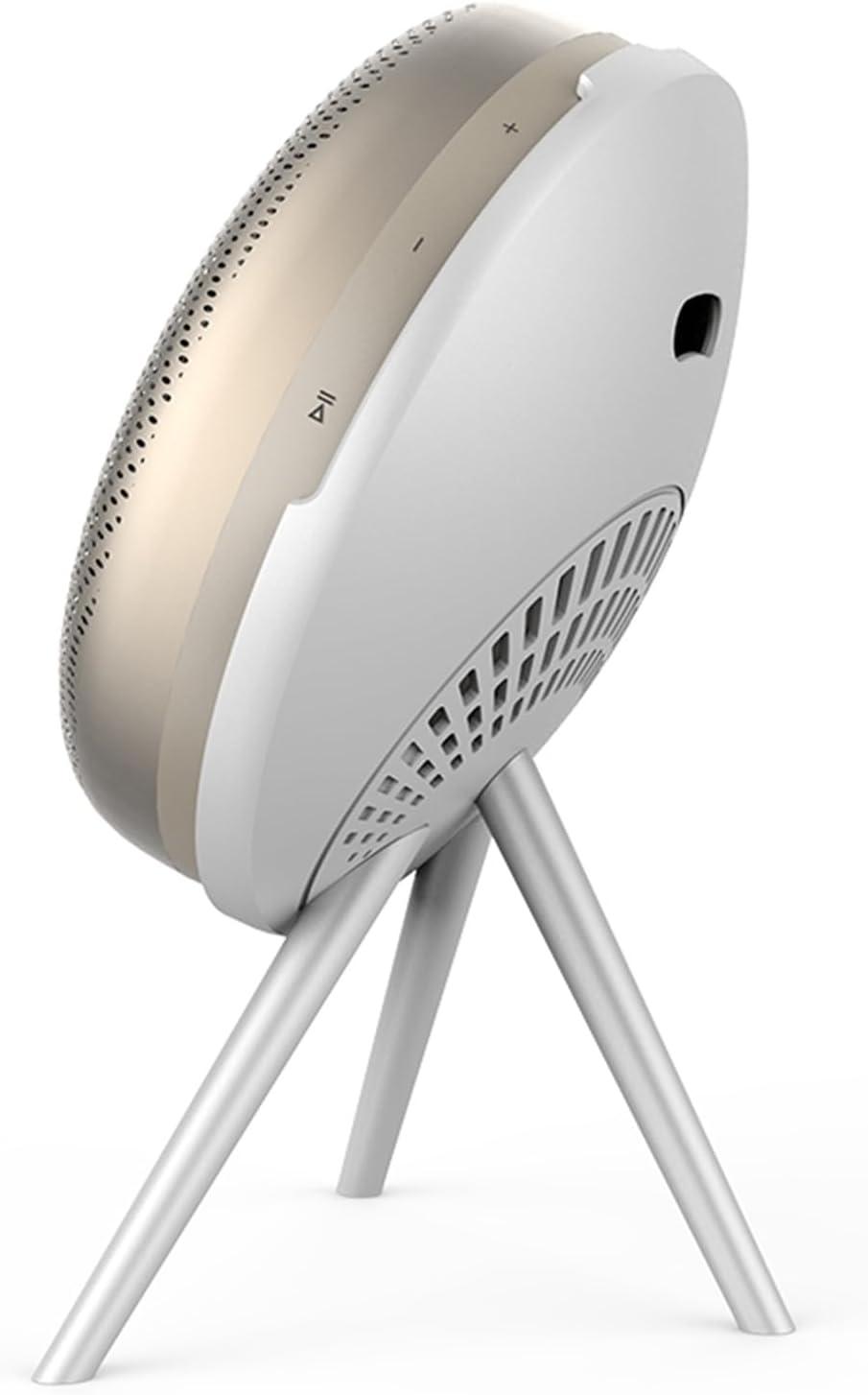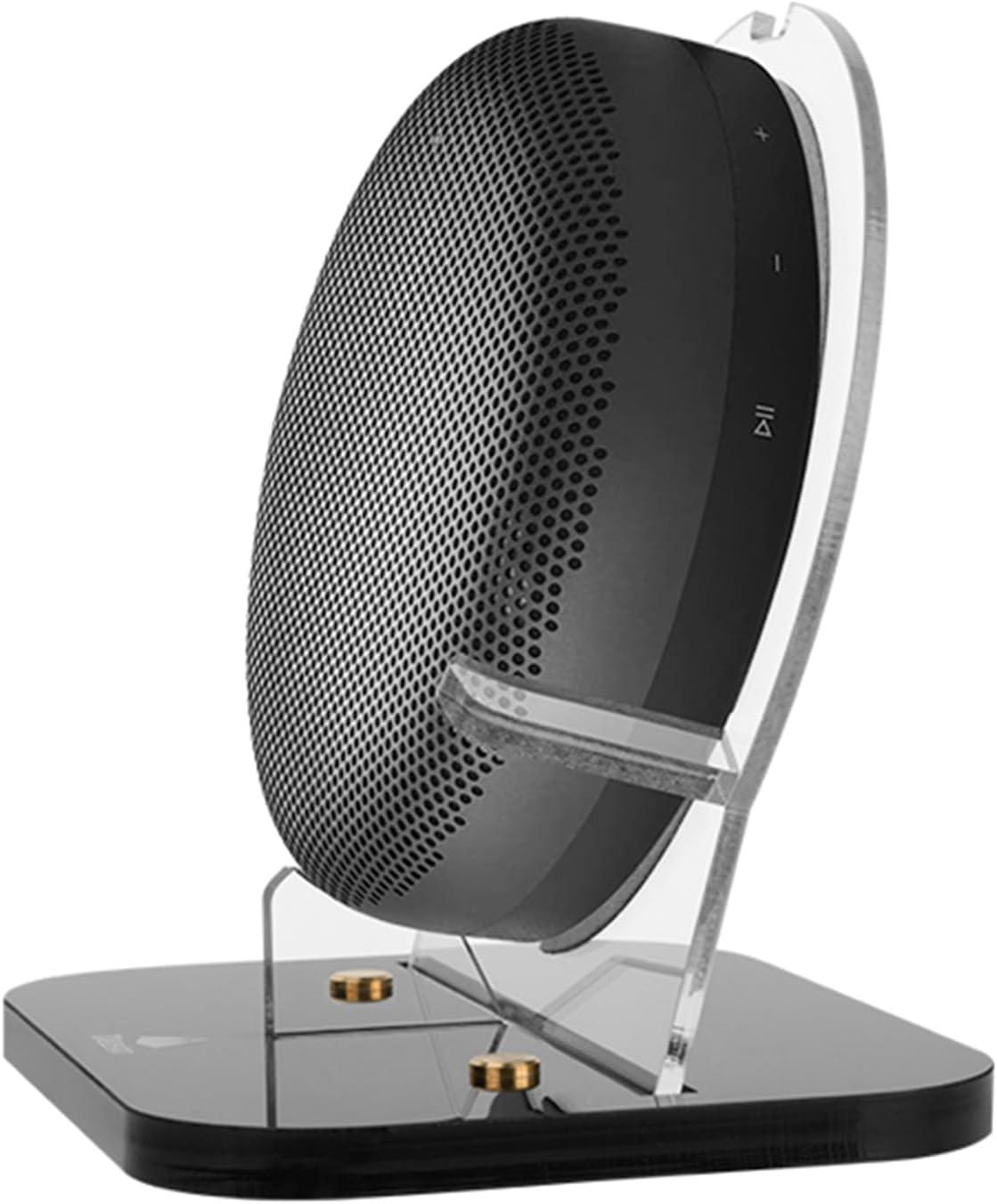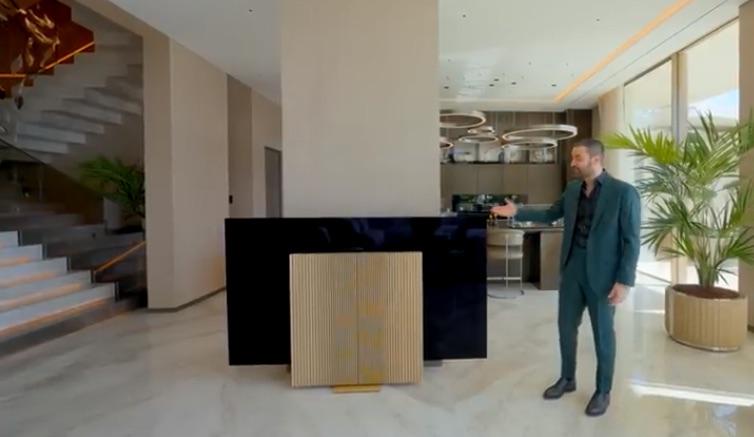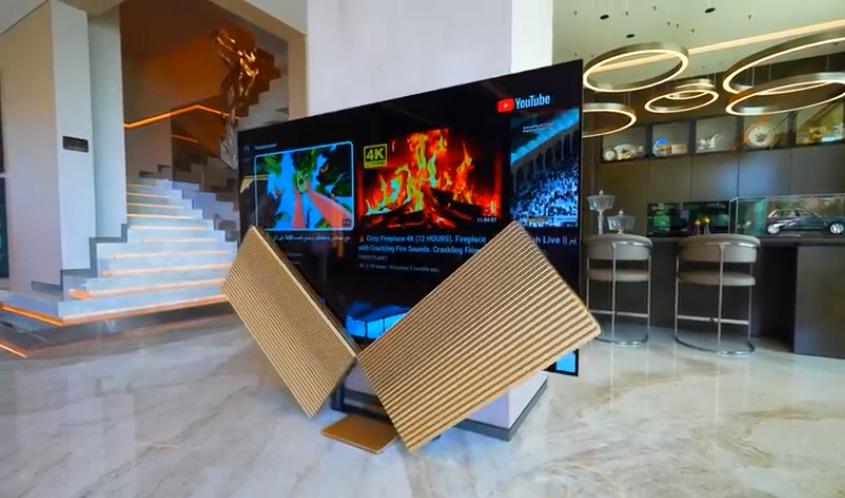Forum Replies Created
- AuthorPosts
-
Gee, now I started looking, turns out there are a few of them. Who knew? (Obviously not me…) This tripod copies the A9 better, and made of ABS, ASIN= B0CZ148696 :

This one’s probably more feature-appropriate (“rubber mat to prevent walking”) but less cute:

Wild guess: You bought a B&O “Aux In” cable, made to take a regular audio component into the Beosystem 7000? If that’s the case, the cable you really want has the RCA/Cinch connectors wired to a different pair of pins inside the DIN. Especially when dealing with sellers who don’t specify (e.g. amazon.com third-party) I always advise buying a 4-RCA<–>DIN cable, which was made for Tape In&Out, that way you can’t go wrong — if there’s no sound, just pick the other pair of RCA’s!
I hate to say it, @SinterKlass, but if static IP addresses doesn’t work, your next debugging step is to take all those (now) wires and hook them up to an un-managed multiport Ethernet switch, using the junky router supplied by your cable ISP (presumably?), and see if the problems go away. The switch will be super-cheap, especially as compared to your B&O equipment, and the router you already have gathering dust in a closet somewhere. The point being, flow-thru of various types of TCP packets, given the Orbis trying to minimize “useless” / “flooding” / “looping” traffic, might be restricted. Easy experiment anyway: if it’s no better, your dealer should have an simple job, subtracting one B&O device at a time.
Don’t even bother contacting The Morons. Last time I did, they started off by asking for the serial numbers of my B&O speakers, despite using the app to send the query, which of course sends them the entire system description embedded in the e-mail! Back and forth, and nothing ever gets fixed. Let your dealer deal. (Of course, if @BeoWillie is to be believed, B&O is telling them in tech notes how to get a fault-free network using… Ubiquiti equipment.)
Like @Stan, I have installed an Orbi setup with 3 nodes, and it ran a Beosound 1 and a Beosound Level together just fine. They coincidentally were using the same Orbi node, though; thus might have been the “easy case”. But also like @Stan, I had old units (RBK) and older software, and security be damned, I never updated it, not wanting to be a beta-tester.
Please update us here if static IP fixed the problem, or if non-Netgear gear worked.
Enes Yilmazer’s YouTube channel of mansion tours has posted another with at least 7 B&O TVs (2 Harmony, 2 Eclipse, 2 BV-Theatre, & 1 Contour). Bonus points if you can spot the BeoRemote 1’s: https://www.youtube.com/watch?v=goFsqVqQ8H8 .

One wag who comments on such videos pointed out that the Beovision Harmony is waaay too big for its place in front of a column and will form a “hazard to navigation” coming from the kitchen! What he didn’t notice is that they sped up the display opening — like they do filming motorized patio doors — because it’s much too slow for snappy video pacing.

I see no “logout” option in the Account menu drop-down once I’m logged in? If there are no “resource issues” or stale connections are terminated, then maybe this doesn’t matter. But I would have logged out as a matter of course, if I could — having an old-fashioned view of website limits.
According to @c-larsen, it is a converter from USB-C to ML interface, for *audio masters* only. I believe this means you can’t push the sound in the other direction to the 9000, nor can you hook the converter up to your BeoVision 10 to get sound or control it. According to @k-rasmussen, he doesn’t believe it can control the BS3200 incl. hard disk. From these 2 informed comments, I feel that either it only works for the BS9000, or if a broader view of @c-larsen’s comment is taken, then at the very least nobody has really tested it with anything else.
@k-rsmussen also said that the 9000 works in Option 0 (no ir) and the Beolab 28 or a Beoremote One can control the CD number, track, play pause, also with the MyButtons. Because ML is used, it’s analog output, not digital (not the SPDIF), so the analog input via USB-C pins as configured in the interface spec in the Beolab 28 can therefore receive A.Aux (& presumably AM/FM in the USA) as well as the CD sound.
“So, I guess, where do the Beolab 18s fit into the equation? Can they connect wirelessly to the Sonos through a Sonos Port connected to a Beoconnect Core?”
Nope, for a Sonos reason: When the sound bar transmits audio to “its own paired” speakers (e.g. Sonos Sub), it does so via a proprietary 5GHz signal direct to them, so all is in sync. But transmitting to the rest of the house is done with a pretty large delay, thru their regular multi-room protocol. Thus the Port (or any other Sonos speakers not dedicated to their soundbar, which, by the way, a Port *cannot* be) would play way behind the TV sound.
Maybe try a B&O Transmitter 1 with a direct connection to the TV? I have no knowledge, whether the HDMI w/Sonos soundbar can also allow, say, headphone listening thru an analog connector. Pretty sure HDMI e-ARC prevents the use of TOSlink optical out inside the TV itself, but ask an expert instead of me. There still may be sync problems even if this works, because the Sonos soundbar still has *some* bit of delay which a different output direct to the 18s might not have. But that at least is worth asking the dealer of {TV&Sonos&B&O}.
@Sandyb, Is there some way to get the “tap the top of your Beosound 1[2][A9] to start/re-start playback” with Roon? I.e. can one make a queue (own music) or playlist (Tidal) that gets auto-continued by the output device rather than by the Roon Controller? That’s principally what I use the BeocrApp for.
In the Sonos app, the Settings tab, tap System.
Select the room with your Port, then tap Line-Out Levels and choose “Variable” instead of “Fixed” or “Pass-Thru” (you wish, be serious).Hmm, a great silence here, not a good sign for your app. And claiming to have reverse engineered — what, exactly? — since B&O have *published* their control spec, seems silly. BUT that said, I *WOULD* pay for a replacement (one-time fee only, I never buy subscription apps). I assume such an app would be analogous to how “Sonopad” works versus the Sonos App: playback control plus more features, using the published spec, and leaving the adding-device / sound settings / registering / account /updates to the native manufacturer app.
A market has been created for you, by B&O themselves: Their playback interface in the new BeoApp on iOS sucks the big one. Can’t drag time slider, screen wastage for “columns” of products showing multi-room status, stealing artwork space and the godawful up-next queue, a tiny little “column” that expands into, well, another tiny little column when you click the icon, the lag in the display, etc. etc. etc. for a crappy UI — plus all the bugs people have been reporting. Who dreams up this garbage?!?!
Anyway, I wish others were more forthcoming to you in saying whether they would (or wouldn’t) buy a decent app replacement, but not holding my breath.
Low voltage like that is not a fire hazard.
Just make the mechanical connection good and tight. It’s the lazy person’s way to do it, but mild corrosion — enough to lower the IR signal — won’t occur for 5-10 years at the worst, by which time you will have upgraded something else. But you know they make tiny wire-nuts for such connections, or if you go high-tech, “Scotch-Lok” gel-filled compression connectors! The only “usual” rule is don’t bury any connections behind solid wall. Push them back into a box with a wall plate, or leave them open and running in the cabinet, whatever.
(If the time ever comes that you want to find the connections again and don’t know where you buried them, you use a telephone linesman’s tool called a “TDR” (Time Domain Reflectometer) to tell you how many feet down the wire your break (or in your case, messy splice) has occurred.)
Patents expired in 2019 (Euro) and 2022 (US).
It does address one of the shortcomings of the 6000s. Who knows how well, proof will be in the listening!
2 April 2024 at 12:19 in reply to: BM6500 / 7000 Powerlink – Attenuated Speaker or True Pre-Amp Out? #54011Novice question for the electronic experts here: Why the 100Ω resistors? Safety load to prevent shorting? Impedance matching, i.e. a dup of some 100Ω later in the amp circuit? IOW, what differentiates the amp next-door in the chassis from an amp down a few meters of cable inside the speakers? When running line-level output around the room, why would one reduce the already-low output? For that matter, I guess the same question is why you can’t hear the plugging-in of Powerlink speakers dropping the volume level to the main out speakers. Basic I’m sure, and I heard “output impedance low –> input impedance high” for line-level amps, but don’t *truly* grok else I might understand the resistors… TIA.
Just buy three (3) pairs of KEF LS60 and one (1) KEF KC92. But close your eyes when you listen. Or anytime you enter any of the three (3) rooms, for that matter.
But seriously, the answer to your actual question is at: https://beoworld.dev.idslogic.net/forums/topic/vhnwi/ or any of @Sandyb’s posts on B&O’s quarterly financial reports, e.g. most recently: https://beoworld.dev.idslogic.net/forums/topic/bo-releases-preliminary-q3-numbers-and-adjusts-revenue-outlook/
Likewise an old Logitech Harmony Home Hub and its iPhone/iPad app. Annoying to configure, and to press on-screen buttons, but it’s cheap (used) and full-function.
19 March 2024 at 02:41 in reply to: B&O releases preliminary Q3 numbers and adjusts revenue outlook……… #53618@Sandyb wrote, “I know they are ok with transitioning to a “leaner” model, but selling less and less at higher and higher prices is awfully risky.” Can you or someone give me the Econ-101 on this?
Presumably there is a breakover point where less&less&less&less becomes “awfully” risky, but at the beginning of the curve, what makes it risky at all? Ignoring any alleged marketing benefits like “scarcity breeds interest”, “rich people buy B&O”, etc. is there any inherent reason to desire, or fear, same revenue on fewer sales? The weak spot seems to be the assumption that you actually *do* continue to keep revenue the same and it doesn’t gyrate unexpectedly, but I don’t see how that’s any riskier than being in business in the first place?
Orange lights indicate the microphone *is* paused. Google wants to listen and makes it slightly obnoxious to mute. Additional note: Same behavior on A9 with GVA. See John O’Manchester’s YouTube video at 4:56. He says “…but you can put some black electrical tape to cover the 4 orange dots.” https://www.youtube.com/watch?v=VQVzFqwRokI&t=296s
I think by “stationary” @Busoni means “not some phone or tablet”. Since the FritzBox is doing DLNA/UPnP with the external drive’s files, I can easily understand your frustration if trying to use the B&O App to play to the A9. Yes, stationary streaming devices exist, and you can see YouTube reviews by @DarkoAudio of the Eversolo DMP-A6, the FiiO R7, and maybe others. But if, as it appears, budget is an issue, I think the cheapest way is the previous-gen Apple iPad for $249, set it to AirPlay to the A9, and glue it to the table! Choosing exactly the right app to scan your DLNA server and act as a source is beyond my ken, hopefully others can help. But the Qobuz app is solid on the iPad, and using Airplay to the speaker is solid too.
Minor feature suggestion: The “Report” drop-down list needs another item: “A.I. B.S.” E.g. user “maiti” which is merely sowing the ground of reputation with inoffensive but useless LLM crap, preparatory to creating whatever harmful post in the future.
Alternate method: Since apparently you aren’t the first person who has been screwed (ha-ha:-) by the heavy-handed assembly crew, ask your dealer to send out a technician to fix this “manufacturing defect” — if the tool bends, it’s their problem the nut was over-torqued, not yours. After enough truck rolls, maybe someone will get the message if every BL18 consumer delivery has a service call for it!
- AuthorPosts
